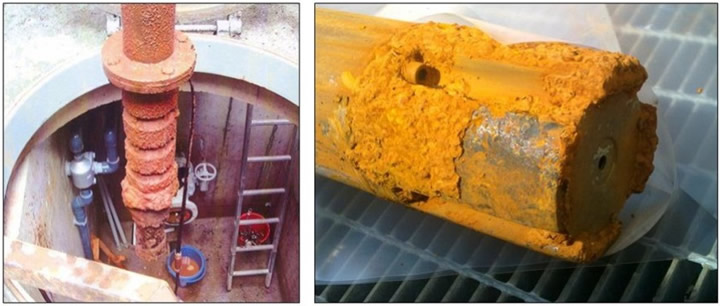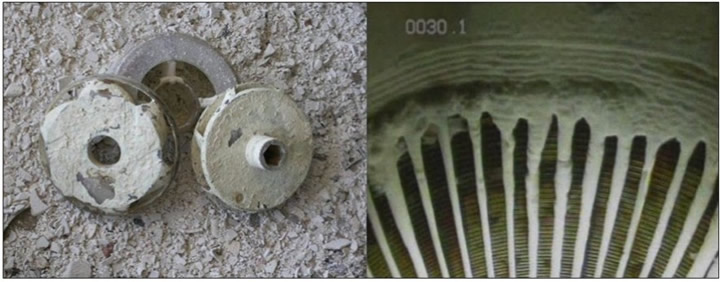Borehole Management in Civil Engineering Projects & Managing Iron Related Bacteria
Groundwater wells are common to many civil engineering schemes and their operational performance can play a crucial role in the successful delivery of a project, whether used for construction dewatering, alternative water supplies for facilities or any other application. Whatever the application, the well performance must be optimised and high levels of operational efficiency and service availability achieved.
A groundwater well is a complex hydrodynamic environment. As water passes through the well and the downstream pumping system, it undergoes pressure changes, temperatures changes, is exposed to the atmosphere and comes into contact with artificial surfaces in well screens and pumps. In many cases this creates the ideal conditions for iron bacteria clogging to occur.
Operational problems caused by iron bacteria clogging include reduction in the hydraulic efficiency of the well (increased drawdown, decreased yield, decreased specific capacity), deterioration of water quality, motor burn out of the submersible pump, and encrustation on the pump, column, well screen and reticulation systems. As a result the energy costs of pumping will increase (due to increased drawdown) and maintenance costs will increase due to greater equipment wear and tear and well rehabilitation costs.
Iron related bacteria are one of the most common clogging processes. The potentially turbulent, oxygenated environment in a well and pumping system provides the energy iron bacteria need by oxidising the soluble ferrous iron (Fe2+) present in the groundwater to an insoluble ferric form (Fe3+). The life cycle of the bacteria produces a biofilm that typically appears as a slimy or gelatinous red-brown/orange deposit and this biofouling can be difficult to remove.

Figure 1. Iron deposits on well pumping equipment
Where carbonate clogging occurs, the natural carbon dioxide dissolved in solution is released, resulting in an increase in water pH. As the pH increases in waters with high levels of calcium carbonates, rapid precipitation of white or pale grey calcareous deposits occur in the well and pump (Figure 2).

Figure 2. Carbonate deposits on well pumping equipment
Boreholes suffering from iron bacteria clogging can be rehabilitated by a range of mechanical and chemical methods. Research has shown that chemical rehabilitation can provide 40 to 60% of the total gain during a combined chemical and hydro- or mechanical rehabilitation. The challenge for the well operator is that each site will have unique aspects, requiring care in the choice of rehabilitation methods and chemical agents. Chemical treatments should be effective against the type of clogging identified, have the necessary regulatory approvals and the post-treatment residues should be harmless and able to be safely disposed.
However, rehabilitation alone is not the optimal solution. The most effective programmes to manage well performance typically incorporate a monitoring and measurement plan alongside a regular chemical treatment. Companies are now starting to routinely deploy planned groundwater well maintenance and well remediation programmes, with proven benefits in terms of operational cost savings and continuity of pumping.
The goal of the BoreSaver borehole maintenance programme is to return borehole production to as close to the original drilled capacity as possible and to help maintain a continual, problem-free water supply. The programme includes a downhole camera survey, bespoke software that analyses the survey results and the available water quality data and BoreSaver, a range of approved borehole rehabilitation treatments that are now used in more than fourteen countries worldwide.
Mike Deed, Managing Director of Geoquip said:
“The BoreSaver programme focuses on proactive maintenance. We encourage people to view their water supply system as they would their car, which, if regularly serviced, will give them trouble-free motoring and won’t break down. Similarly, with a water supply system, the operation of the pumps and associated equipment, the specific capacity and quality of the water will be optimised if the system is regularly maintained.”
An example of the maintenance programme in action was the construction of a new metro system. The groundwater level was within two metres of ground level. Dewatering and associated artificial recharge was required. Within the first six months of dewatering pumping, severe levels of iron-related clogging were discovered with the pumps and pipes so badly clogged that the pumps could not be used to maximum efficiency. There were additional problems with the back-pressure of the artificial recharge system, which reached 1,400 kPa, resulting in low rates of recharge flow. The pumps, pipes and recharge bore were treated with a combined mechanical and chemical treatment using BoreSaver Ultra C and a surging technique. This removed the iron related bacteria deposits and within minutes of the chemical treatment the back- pressure in the recharge system reduced by 550 kPa. A regular chemical treatment regime was then implemented to maintain the recharge flow rates. A weekly treatment of the dewatering pumps with BoreSaver Ultra C was also initiated and the pumps were quickly brought back into full service and maintained at optimum operational levels.
For organisations where there is a need for continual flow to maintain operations, limited monitoring and maintenance regimes can have huge financial implications. Regular monitoring, proactive maintenance and knowing when to call in well rehabilitation experts can maintain or even increase specific capacity and it is now becoming common to build in such a programme at the design stage rather than waiting until operations commence and a problem occurs.

